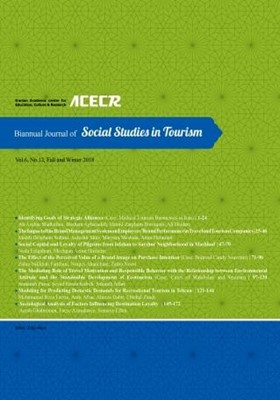Sociological Analysis of Factors Influencing Destination Loyalty
Subject Areas :طیبر ظیسبل 1 * , 2 , سميه عفتی 3
1 -
2 -
3 -
Keywords: religious tourism# destination loyalty# trip satisfaction# Structural Equation Modeling#,
Abstract :
This paper is a part of a survey. It applies structural equal modeling techniques to analyze factors that influence tourism destination loyalty. The approach was “Tourism as a customer.” The customer buys leisure services from the provider and the destination. One model in this approach is the European Customer Satisfaction Index. Based on this model, variables influencing the loyalty of tourists to the host community are not just the service provided by the host community. Rather, loyalty is correlated to the image of the destination, and the related expectations of that image. The statistical population was the families and parents of the martyrs in Mashhad. The sample included 400 cases selected by stratified sampling. Based on regression coefficients, perceived value and perceived quality were factors that influenced trip satisfaction. The final model of path analysis showed perceived value and perceived quality influenced trip satisfaction. Perceived quality impacted life satisfaction both directly and indirectly. We considered this perceived value as a mediate variable. Perceived quality leads to a positive evaluation of travel achievement, and it increases trip satisfaction.
چلبی، مسعود. (1375). رضايت شهروندان تهرانی از عملکرد شهرداری . تهران: شهرداری تهران.
خوارزمی رحيم آبادی، ر. ا. (1382). بررسی ميزان رضايتمندی خانواده های معظم شاهد از خدمات رفاهی و فرهنگی ارائه شده از سوی بنياد شهيد. بازیابی از www.irandoc.ac.ir.
رفيع پور، فرامرز. (1372). سنجش گرايش روستاييان نسبت به جهاد سازندگی. نشر ارغنون. صديق اورعی، غ. ب. (1383). بررسی ميزان رضايت مشترکين شرکت آب و فاضلاب خراسان. استان خراسان: شرکت آب و فاضل آب .
عظيمی هاشمی، مژگان. (1381). طرح پژوهشی نظرسنجی رضايتمندی مراجعين از سازمان صنايع و معادن خراسان. جهاددانشگاهی مشهد.
قاسمی، وحيد. (1389). مدلسازی معادله ساختاری در پژوهش های اجتماعی. تهران: جامعه شناسان.
کلانتری، خليل. (1388). مدل سازی معادلات ساختاری در تحقيقات اجتماعی ـ اقتصادی. تهران: فرهنگ صبا.
منصور فر، کريم. (1384). روشهای آماری. تهران: انتشارات دانشگاه تهران.
Bosque , I. d., & Martı´ n, H. S. (2008). TOURIST SATISFACTION A Cognitive-Affective Model. Annals of Tourism Research, 35, 551–573.
Chen, C. and F. Chen. (2010). Experience quality, perceived value, satisfaction and behavioral intentions for heritage tourists. Tourism Management, 31: 29–35.
Chi, C., and H. Qu. (2008). Examining the structural relationships of destination image, tourist satisfaction and destination loyalty: An integrated approach . Tourism Management, , 29: 624–636.
Çoban, S. (2012). The Effects of the Image of Destination on Tourist Satisfaction and Loyalty: The Case of Cappadocia. European Journal of Social Sciences, Vol.29 No.2 (2012), pp. 222-232.
Coelho, P., & Esteves, S. (2009). The choice between a 5-point and a 10-point scale in the framework of customer. www.isegi.unl.pt.
Dimanche, F. & Havitz, M. E. . (1994). Consumer behavior and tourism: Review and extension of four study areas. Travel and Tourism Marketing, 3(3), 37–58.
Flavian, C. et al. (2001). Loyalty to grocery stores in the Spanish market of the 1990s. Journal of Retailing and Consumer Services, 8, 85–93.
Haung, f. and L. Su. (2010). A Study on the Relationships of Service Fairness, Quality, Value, Satisfaction, and Loyalty among Rural Tourists.
Paper presented at 7th International Conference on Service Systems and Service Management. Tokyo.
Hui, T., D. Wan, and A. Ho. (2007). Tourists’ satisfaction, recommendation and revisiting. Tourism managment, 28,965-975.
Kozak, M. ; Rimmington, M. (2000). Tourist satisfaction with Mallorca, Spain, as an off-season holiday destination. Travel Research, 38(3), 260–269.
Lau,A.L.S.,& McKercher, B. (2004). Exploration versus acquisition: A comparisonof first time and repeat visitors. Journal of Travel Research, 42(3), 279-285.
Lee, C. K., Y. S. Yoon, and S. K. Lee. ( 2007). Investigating the relationships among perceived value, satisfaction, and recommendations: The case of the Korean DMZ. Tourist management, 28 (2): 204-214 .
lertwannawit, a., & gulid, n. (2011). international tourists' servicequality perceptionand behavioral loyalty toward medical tourism in bangkok metropolitan area. the journal of applied business research, 27, 1-11.
Lobato, L.H., et.al. (2006). “Tourism Destination Image, Satisfaction and Loyalty: A Study in Ixtapa-Zihuatanejo, Mexico”. Tourism Geographies, Vol. 8, No. 4, pp.343–358.
Mingfang, Z. (2010). Examining the structural relationships of tourist characteristics and destination satisfaction. International Conference on E-business, Management and Economics, (p. vol.3). Hong Kong.
Prayag, G. (2008). “Image, Satisfaction and Loyalty-The Case of Cape Town”. International Journal of Tourism and Hospitality Research,, 19, (2), pp. 205-224.
Sadeh E; et al. (2012). Factors Affecting Tourist Satisfaction and Its Consequences. Journal of Basic and Applied Scientific Research, 2(2)1557-156.
Sadeh, E., L. Mousavi, M. Garkaz, and S. Sadeh. ( 2011). The structural model of e-service quality e-customer satisfaction, trust, customer perceived value and e-loyalty. Australian Journal of Basic and Applied Sciences, 5 (3): 532-538.
Song, H., R. Veen, G. Li, and J. Chen. (2011). THE HONG KONG TOURIST SATISFACTION INDEX. . Annals of Tourism Research, x(x): xxx-xxx.
Su, L. and X. Fan. (2011). A Study on the Relationships between Service Quality, Satisfaction,Trust and Loyalty among Rural Tourism. Paper presented at 8th International Conference on. Tianjin.
Valle , P. d., & et al. (2006). Tourist Satisfaction and Destination Loyalty intention: A Structural and Categorical Analysis. Int. Journal of Business Science and Applied Management, 1(1), 25-44.
Xia, W., Z. Jie, G. Chaolin, and Z. Feng. (2009). Examining Antecedents and Consequences of Tourist Satisfaction: A Structural Modeling Approach. TSINGHUA SCIENCE AND TECHNOLOGY, 14 (3): 397-406.
yerian, s., & okello, m. m. (2009, September). tourism satisfaction in relation to attractions and implications for conservation in the protected areas of the Northern Circuit, Tanzania. Journal of Sustainable Tourism, 605-625.
Yoon, Y., & Uysa, M. (2005). An examination of the effects of motivation and satisfaction on destination loyalty: a structural model. Tourism Management, 26, 45-56.

